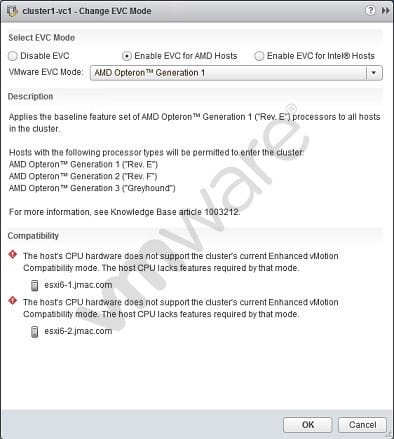Exam Details
Exam Code
:2V0-620Exam Name
:vSphere 6 Foundations BetaCertification
:VMware CertificationsVendor
:VMwareTotal Questions
:191 Q&AsLast Updated
:Dec 18, 2024
VMware VMware Certifications 2V0-620 Questions & Answers
-
Question 81:
What are three valid disk configurations for the vSphere Data Protection 6.x Appliance? (Choose three.)
A. 500GB
B. 1TB
C. 1.5TB
D. 2TB
E. 4TB
-
Question 82:
An administrator is attempting to restore a number of files in a directory within the Operating System of a virtual machine.
How can the administrator restore the files from a previous backup?
A. Use the File Level Restore option from the selected backup of the virtual machine in the vSphere Web Client.
B. Connect to the File Level Restore tool from a web browser in the virtual machine.
C. Connect to the File Level Restore tool from the VMware Data Protection appliance.
D. Use the File Level Restore option from the selected backup of the virtual machine in the vSphere Client.
-
Question 83:
Which two statements are true about deploying and using vSphere Replication? (Choose two.)
A. ESXi hosts managed by a single vCenter Server instance require a connection between the two vSphere Replication appliances.
B. Sites managed by different vCenter Server instances require a connection between the two vSphere Replication appliances.
C. Sites managed by different vCenter Server instances require the use of Site Recovery Manager and a connection between the two vSphere Replication appliances.
D. ESXi hosts managed by a single vCenter Server instance require a single vSphere Replication appliance.
-
Question 84:
A vSphere administrator needs to backup a virtual machine that has a Microsoft SQL Server Database installed.
Which solution allows for an application quiesce to occur during backup?
A. VMware vCenter Converter
B. VMware vCenter Site Recovery Manager
C. VMware vSphere Replication
D. VMware vSphere Data Protection
-
Question 85:
An administrator must determine an appropriate backup solution, given these conditions:
50 of the virtual machines are in a resource pool named Finance.
50 of the virtual machines are in a resource pool named QA.
Which solution allows an administrator the ability to backup 100 virtual machines?
A. Use Snapshot Manager on the vCenter Server to backup the virtual machines.
B. Use the VMware Consolidated Backup (vcb) tool on the ESXi Host to backup the virtual machines.
C. Use the VMware Data Recovery (VDR) Appliance on the vCenter Server to backup the virtual machines.
D. Use the VMware Data Protection (VDP) Appliance on one of the ESXi Hosts to backup the virtual machines.
-
Question 86:
An administrator attempts to migrate a suspended virtual machine to a newly deployed vSphere 6.x cluster. The compatibility check fails.
What condition could cause this behavior?
A. The new vSphere 6.x cluster is running Intel CPUs instead of AMD CPUs.
B. A suspended virtual machine cannot be migrated.
C. The hardware virtualization feature of the CPU is not enabled on the new hosts.
D. A vSphere Distributed Switch is required to migrate a suspended virtual machine.
-
Question 87:
An administrator is attempting to migrate a large Hadoop virtual machine using vMotion. The administrator notices a delay when the machine is quiesced. The Hadoop virtual machine is processing many transactions a second to an in- memory database.
Which two actions would help reduce the amount of time needed to perform a vMotion on this virtual machine? (Choose two.)
A. Use multiple NICs for the vMotion vmkernel port.
B. Use a 10Gbps Network card for the vMotion vmkernel port.
C. Add an additional management network to help transmit the data quicker.
D. Disable Fault Tolerance before performing the vMotion.
-
Question 88:
Refer to the Exhibit.

An administrator attempts to enable Enhanced vMotion Compatibility (EVC) on a cluster. The operation results in a compatibility error, as shown in the exhibit.
What is the likely cause of this error?
A. The CPUs in the ESXi host are not AMD CPUs.
B. The CPUs in the ESXi host do not support hardware virtualization capabilities.
C. The XD/NX CPU features have not been enabled in the BIOS of the server.
D. There is no shared storage between the hosts in the cluster.
-
Question 89:
What is a benefit of using Enhanced vMotion Compatibility for an environment?
A. EVC masks CPU features to allow compatibility between hosts that are dissimilar.
B. EVC allows for cross platform vMotion to occur.
C. EVC enables Long Distance vMotion.
D. EVC enables Storage vMotion functionality.
-
Question 90:
An administrator is migrating a virtual machine from a Test cluster to a Production cluster. The two environments do not have any shared storage.
What is the easiest way to accomplish this task?
A. Perform a Storage vMotion.
B. Perform a regular vMotion.
C. Perform a Virtual to Virtual migration.
D. Perform a backup and restore using VMware Data Protection.
Related Exams:
1V0-21.20
Associate VMware Data Center Virtualization1V0-31.21
Associate VMware Cloud Management and Automation1V0-41.20
Associate VMware Network Virtualization1V0-61.21
Associate VMware Digital Workspace1V0-71.21
Associate VMware Application Modernization1V0-81.20
Associate VMware Security2V0-11.24
VMware Cloud Foundation 5.2 Administrator2V0-11.25
VMware Cloud Foundation 5.2 Administrator2V0-13.24
VMware Cloud Foundation 5.2 Architect2V0-21.20
Professional VMware vSphere 7.x
Tips on How to Prepare for the Exams
Nowadays, the certification exams become more and more important and required by more and more enterprises when applying for a job. But how to prepare for the exam effectively? How to prepare for the exam in a short time with less efforts? How to get a ideal result and how to find the most reliable resources? Here on Vcedump.com, you will find all the answers. Vcedump.com provide not only VMware exam questions, answers and explanations but also complete assistance on your exam preparation and certification application. If you are confused on your 2V0-620 exam preparations and VMware certification application, do not hesitate to visit our Vcedump.com to find your solutions here.